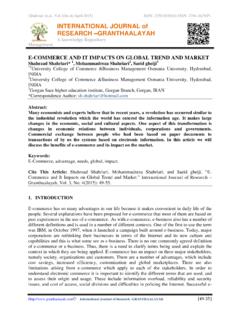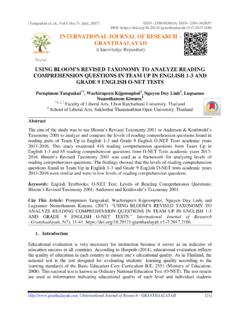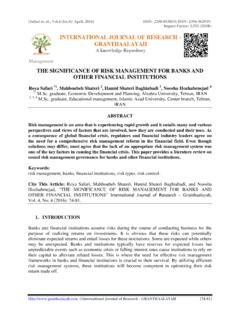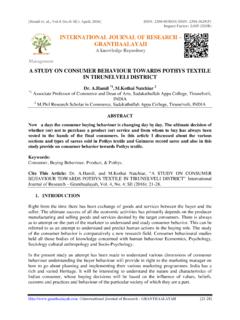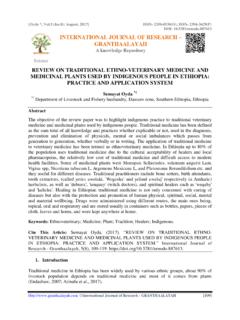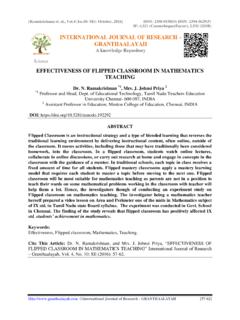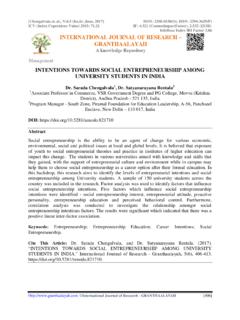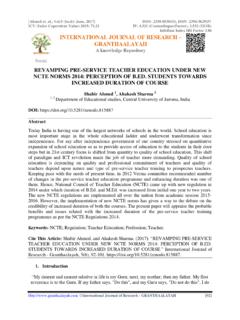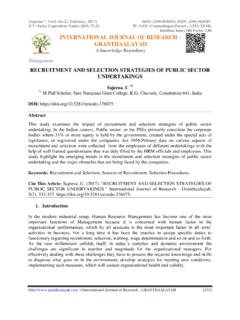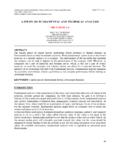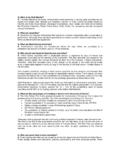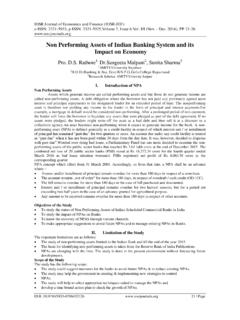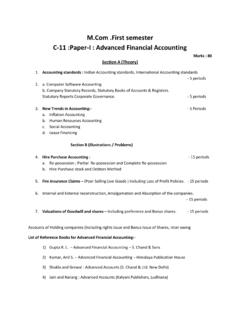Transcription of THE ROLE OF FORWARD MARKETS COMMISSION …
1 [Bhagwat et. al., ( ): November, 2015] ISSN- 2350-0530(O) ISSN- 2394-3629(P). Impact Factor: (I2OR). Management THE ROLE OF FORWARD MARKETS COMMISSION IN INDIAN. COMMODITY MARKETS . Dr. Shree Bhagwat *1, Angad Singh Maravi 2. *1. Asst. Prof., Department of Business Management, Dr. Harisingh Gour Central Vishwavidyalaya, Sagar, Madhya Pradesh, INDIA. 2. Research Scholar, Department of Commerce, Dr. Harisingh Gour Central Vishwavidyalaya, Sagar, Madhya Pradesh, INDIA. ABSTRACT. This paper examines the role of FORWARD MARKETS COMMISSION (FMC) in Indian Commodity MARKETS . The Results show important developments of FORWARD MARKETS COMMISSION . Commodity futures and derivatives have a crucial role to play in the price risk management process, especially in agriculture sector.
2 The significance of commodity derivatives has increased in the current scenario. India has long history of trade in commodity derivatives. Organized commodity derivatives in India started as early as 1875, barely about a decade after they started in Chicago. Since 2003, when commodity futures' trading was permitted, commodity futures market in India has experienced an unprecedented boom in terms of the number of modern exchanges, number of commodities allowed for derivatives trading as well as the value of futures trading in commodities. There are 6 national and 16 regional commodity exchanges recognized and regulated by the FMC. Different types of commodities such as agricultural; bullion, plantation, energy etc. is traded on commodity exchanges in the country.
3 So considering these points an attempt has been made to know the regulatory framework of commodity futures and derivatives market in India and various developments in Indian commodity market and commodity exchanges. This study is an attempt to investigate the performance of FORWARD MARKETS COMMISSION in India and its role in Indian commodity market. Keywords: Commodity Derivatives and Futures Market, Commodity Exchanges, FMC, Ministry of Finance. Cite This Article: Dr. Shree Bhagwat, and Angad Singh Maravi, THE ROLE OF FORWARD . MARKETS COMMISSION IN INDIAN COMMODITY MARKETS International Journal of Research Granthaalayah, Vol. 3, No. 11(2015): 87-105. 1. INTRODUCTION. Commodity trading in India has a long and rich history.
4 The history of commodity Futures market in India dates back to the ancient times citied in Kautialya's Arthasastra', Words like, Teji , International Journal of Research - GRANTHAALAYAH [87-105]. [Bhagwat et. al., ( ): November, 2015] ISSN- 2350-0530(O) ISSN- 2394-3629(P). Impact Factor: (I2OR). Mandi , Gali , and Phatak have been commonly heard in Indian MARKETS for centuries which seems to be coined in 320 BC and also referred in FORWARD Contracts (Regulation) Act, 1952 ;The first organized futures market in India was however established in 1875 under the aegis of the Bombay Cotton Trade Association to trade in cotton contracts. This was followed by establishment of futures MARKETS in edible oilseeds complex, raw jute and jute goods and bullion.
5 Post-independence, in the 1950s, India continued to struggle with feeding its population and the government increasingly restricting trading in food commodities. In independent India, the FORWARD Contracts (Regulation) Act was enacted in 1952 to regulate the commodity trading in FORWARD and futures contracts. Just as SEBI regulates the stock exchanges, commodity exchanges are regulated by FORWARD MARKETS COMMISSION (FMC); Forwards Market COMMISSION works under the purview of the Ministry of Finance, Department of Economic Affairs. FORWARD MARKETS COMMISSION is a regulatory body for commodity futures/ FORWARD trade in India. This was set up under the FORWARD Contracts (Regulation) Act of 1952. It is responsible for regulating and promoting futures/ FORWARD trade in commodities.
6 At present, there are three tiers of regulations of FORWARD /futures trading system exists in India, namely, Government of India, FORWARD MARKETS COMMISSION (FMC) and Commodity Exchanges. Government of India, in 2002-03, has demonstrated its commitment to revive the Indian agriculture sector and commodity futures MARKETS . Prime Minister's Independence Day address to the nation on August 15, 2002, which enlisted nation-building initiatives, included setting-up of national commodity exchange among the important initiatives. The year 2002-03, certainly, was an eventful year in terms of regulatory changes and market developments that could set the agenda for development for the years to come. In 2003, a prohibition on futures trading in all commodities was lifted and recognition was granted to three national commodity electronic exchanges, the MCX, NCDEX and NMCE.
7 The only financial product currently traded on commodity exchanges in India is futures. FORWARD contracts are traded in the Over-the-Counter (OTC) market. There are six national commodity exchanges: the Multi Commodity Exchange (MCX); the National Commodity and Derivatives Exchange (NCDEX); the National Multi Commodity Exchange (NMCE); the Indian Commodity Exchange; ACE Derivatives & Commodity Exchange Limited (ACE); and the Universal Commodity Exchange Ltd. (UCX). Apart from these, there are 16. regional exchanges. The FORWARD MARKETS COMMISSION (FMC) is an independent body involved with the regulation of all commodity exchanges. Futures' trading is organized in such goods or commodities as are permitted by the government.
8 Trading in commodity futures contracts can be done between, with and through the members of the recognized Exchanges. At present, 113. commodities are allowed for futures trading under the auspices of the commodity exchanges recognized under the F C (R) Act. 2. OBJECTIVES OF THE STUDY. To study the role of FORWARD MARKETS COMMISSION in Indian commodity MARKETS To evaluate the working of FORWARD MARKETS COMMISSION in Indian commodity market. To analyze the important developments of FORWARD MARKETS COMMISSION International Journal of Research - GRANTHAALAYAH [87-105]. [Bhagwat et. al., ( ): November, 2015] ISSN- 2350-0530(O) ISSN- 2394-3629(P). Impact Factor: (I2OR). 3. REVIEW OF LITERATURE. Sathya S. (2015) in his study A Comparative Study on Equity, Commodity, Currency Derivatives in India - Evidence from Future Market with special reference to BSE Ltd, Mumbai examine that the Derivatives are financial contracts whose value is derived from some underlying asset.
9 These assets can include equities and equity indices, bonds, loans, interest rates, exchange rates, commodities. The contracts come in many forms, but the more common ones include options, forwards/futures and swaps. The results shows negatively correlated with equity, commodity, and currency returns. Panda Rajesh (2014) in his study Soybean Price Forecasting in Indian Commodity Market: An Econometric Model examine that the Econometric analysis of the data for the seed prices of soybean helped in understanding the underlying pattern in the data. After analyzing the data of 160 observations, it's apparent that proposed model of ARIMA (1, 1, 0) with additive seasonality predicts the nature of fluctuation and explains the underlying seasonality.
10 This model can be used by traders, harvesters to minimize the scope for speculation and assume the change in prices of soybean seed for near future. They found that the model can also be used by regulators to predict the future prices and minimize the role of speculators who may otherwise destabilize the market pricing mechanism. Irfan ul haq and K Chandrasekhara Rao (2014) in his paper Efficiency of Commodity MARKETS : A Study of Indian Agricultural Commodities . investigated the efficiency of Indian agricultural commodities futures market through the use of time series methodologies. The MARKETS for all the ten commodities included in the study are efficient in long run. However, short run inefficiencies and pricing biases exist, which can be attributed to dynamic lag structure and slow adjustment to long run equilibrium.
